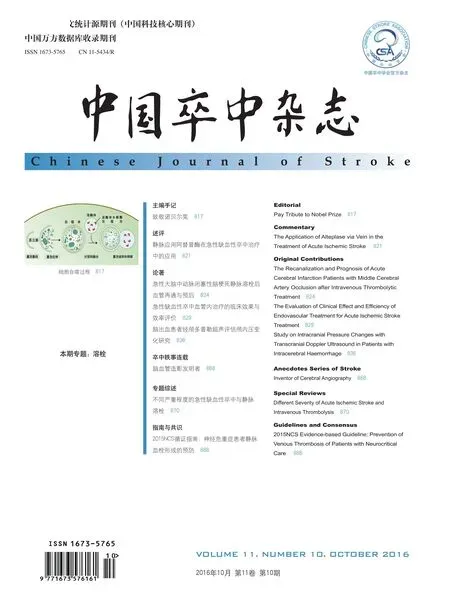不同严重程度的急性缺血性卒中与静脉溶栓
王丹丹,陈胜云,赵性泉
卒中是指由于急性脑循环障碍所致的局限性或全面性脑功能缺损综合征。在2010年全球疾病负担(global burden of disease,GBD)研究报告中提示,卒中已成为全球影响伤残调整生命年(disability-adjusted life years,DALYs)减少的第三大主要疾病,较1990-2010年的20年间,无论是患病人数、死亡人数还是总体DALYs减少的疾病排名均有所上升[1-2]。虽然在2013年的GBD研究中卒中的DALYs有所增加,但其排名并没有改变[3]。在中国,卒中更是超越心血管疾病,成为导致DALYs减少和死亡的第一大原因[4-5]。因此,卒中的诊断、治疗与预防越来越受到人们的关注与重视。静脉应用阿替普酶进行溶栓治疗是改善急性缺血性卒中预后的最有效方法[6-7],但不同患者静脉使用溶栓治疗后其临床预后及结局也不尽相同。患者溶栓后的效果及预后受到许多因素的影响,包括患者年龄、卒中严重程度、症状出现到用药的时间等等[8-9]。
1 关于溶栓的新声明
2016年2月,美国心脏协会(American Heart Association,AHA)、美国卒中协会(American Stroke Association,ASA)共同发布了急性缺血性卒中静脉应用阿替普酶纳入和排除标准科学原理的声明。在声明中陈述了部分影响预后的指标与溶栓之间的关系。其中,关于不同卒中严重程度与应用静脉溶栓的推荐与2013年AHA/ASA发布的声明有些变化,大体总结为以下几点:①对于症状严重的卒中患者,应当在症状开始3 h内静脉使用阿替普酶。尽管会增加出血转化的风险,但仍有临床证据证实对这些症状严重的卒中患者是有益的(Ⅰ级推荐,A级证据)。②对于症状轻微,但是有残疾可能的卒中患者,应当在症状开始3 h内静脉使用阿替普酶。临床医师在静脉使用阿替普酶治疗上对于这些症状轻微但是有致残可能的卒中患者是不应该主观排除的,因为有临床证据证明对于这些患者来说静脉溶栓是有益的(Ⅰ级推荐,A级证据)。③在症状出现3 h内对于症状轻微且判断没有致残风险的卒中患者,静脉阿替普酶治疗是待考虑的。治疗的风险要与获益相权衡;然而,医务人员需要更多的研究来定义未来的风险获益比值(Ⅱb级推荐,C级证据)[10-11]。
2 症状严重的卒中和溶栓治疗
起初,美国食品药品管理局(Food and Drug Administration,FDA)的有关声明中对于NIHSS>22分的卒中患者使用阿替普酶静脉溶栓治疗的观点是谨慎的,AHA/ASA发布的关于静脉溶栓的声明中也将NIHSS>25分作为3~4.5 h溶栓的排除标准之一[11],因为在两个相关的国家神经疾病和卒中研究所(National Institute of Neurological Disorders and Stroke,NINDS)试验中,研究者发现症状严重的卒中患者溶栓治疗后更容易出现出血转化[12]。出血转化是急性缺血性卒中患者静脉溶栓后最常见的并发症,通常与梗死患者血管屏障破坏、缺血再灌注损伤或侧支循环开放相关[13-14]。但是实际上,无论是否使用溶栓治疗,症状严重的卒中患者较症状轻微的卒中患者其出血转化的风险本身就是高的[15]。并且卒中的严重程度本身就是出血的独立预测指标之一,与是否进行溶栓治疗无关[16]。虽然既往研究提示,进行溶栓治疗的卒中患者中,临床症状轻(NIHSS<20分)是预测良好结局的重要指标之一[17]。但是NINDS关于溶栓治疗急性卒中的研究中发现,卒中的严重程度并不能成为影响预后的独立预测指标,那些临床症状严重(NIHSS>20分)的卒中患者在使用阿替普酶进行溶栓治疗后同样可以观察到一个明显且独立的治疗效果[18]。综上所述,静脉使用阿替普酶可以改善那些症状严重的卒中患者的临床预后,因此医务人员不应把有高出血风险作为症状严重卒中患者不使用溶栓治疗的一个理论依据[10]。
总结既往的研究和最近发表的第三次国际卒中试验(the third international stroke trial,IST-3)研究,医务人员发现,虽然与症状较轻的卒中比较,对临床症状重的卒中患者进行溶栓治疗的效果没有更好,但是与不进行溶栓治疗比较,对症状严重的卒中患者进行溶栓治疗其出现良好结局的比例还是更大的。在IST-3研究中,医务人员按照NIHSS评分将入组者分为不同亚组,评价其溶栓6个月后的结局事件(是否存活或独立生活),发现整体比较来讲,不同亚组间其结局事件发生的比例有显著性差异。具体比较中,发现随着卒中的严重程度增加,其发生良好结局事件的OR值有逐步的提高,这一结果虽然没有经过校正,也没有统计学差异,但是医务人员不能不承认,这已经为症状严重的卒中患者进行溶栓治疗提供了一个较为积极的证据[19]。
如上文所提到的NIHSS评分,还有目前在临床中应用的溶栓后出血评分(Hemorrhage After Thrombolysis,HAT),安全治疗卒中——颅内出血(Safe Implementation of Treatments in Stroke–Intracerebral Hemorrhage,SITS-ICH),缺血性卒中预测风险评分(Ischemic Stroke Predictive Risk Score,iSCORE)评分等等,最近越来越多的评分被广泛应用在卒中患者治疗的风险评估中[20-23],这些评分的目的并不在于决定是否要使用阿替普酶溶栓治疗,相反的,通过对溶栓患者进行评分,医务人员可以更好地了解其发生并发症的风险比例有多大[21-24]。
3 症状轻微的卒中和溶栓治疗
在最初的NINDS研究中,研究者并未对入组患者的NIHSS评分设置低限,在选择入组患者时,研究者被要求入组“引起了可检测的神经功能缺损症状,如语言、运动、认知障碍和(或)凝视,视力障碍或忽视”的缺血性卒中患者。但是到底哪些轻微卒中可以引起致残结局却不是那么简单和直观就能被研究者发现的。一些研究提示,在随访3个月时,有相当一部分的起初症状轻微的卒中患者出现了致残的临床表现和症状[25-27],其中一些是预期出现的运动障碍,还有一大部分是关于认知功能障碍、疲劳、抑郁以及NIHSS评不上分的功能缺陷。虽然有一些卒中症状被大多数卒中专科医生认可是可致残的(如严重的偏瘫或失语),但仍有相当一部分卒中患者虽然症状轻微但仍有不良结局与预后的风险[27-30]。这些轻微卒中患者有不良预后的原因多样,包括了在后续随访时出现再次卒中的风险,最初轻微卒中后神经功能恶化的风险,或者没有很好进行NIHSS测评的神经功能缺损引起的预期以外的致残等等。而那些发病最初症状严重的卒中患者以及影像学可见的动脉阻塞的患者则有较高的神经功能缺损的风险[31-32]。
阿替普酶治疗对于一些尽管NIHSS评分很低但有致残风险的卒中患者而言可能是合适的。在一个析因荟萃分析中,NINDS研究者同时采用了5个不同的轻微卒中的定义,并在所有定义的轻微卒中中均发现了使用阿替普酶是有益的[33]。然而,目前并没有关于症状轻微且没有潜在致残风险的卒中患者使用阿替普酶效果的数据。因为有近3000个该类卒中患者在NINDS试验由于症状轻微而被排除,在这两个试验中,关于症状轻微的卒中有关的任何分析都是比较困难的。单中心研究和澳大利亚一个大型登记研究提示对轻微卒中患者进行溶栓治疗是有益的[34-35]。
在有关文献中,症状轻微的卒中患者的出血转化风险要远低于症状严重的卒中患者,仅有0~2%[36-39]。然而,这些发现只在小型研究中得到证实,并且结果的可信区间很宽。目前来看,仅有相当少数的静脉溶栓研究包括了症状轻微的卒中患者,因此对于这些患者的风险受益比值目前仍是未知的并且需要进行更多的研究给予证实。
当然,影响卒中患者静脉溶栓效果的影响因素还有很多,目前声明中的纳入和排除标准只是对大部分患者而言是合适的,每一个人都存在着一定的个体差异,不同地区、种族之间也存在着地域和生活习惯等的差异,因此对静脉溶栓的效果也不尽相同。在未来的研究中,医务人员会继续关注与急性缺血性卒中患者静脉溶栓相关的因素分析,关注不同严重程度的卒中患者静脉溶栓后安全性及有效性的分析,以获得更加全面的认识,探索相关领域更多的奥秘。
1 Murray CJ,Vos T,Lozano R,et al.Disabilityadjusted life years (DALYs) for 291 diseases and injuries in 21 regions,1990-2010:a systematic analysis for the Global Burden of Disease Study 2010[J].Lancet,2012,380:2197-2223.
2 Feigin VL,Forouzanfar MH,Krishnamurthi R,et al.Global and regional burden of stroke during 1990-2010:findings from the Global Burden of Disease Study 2010[J].Lancet,2014,383:245-254.
3 GBD 2013 DALYs and HALE Collaborators,Murray CJ,Barber RM,et al.Global,regional,and national disability-adjusted life years (DALYs) for 306 diseases and injuries and healthy life expectancy(HALE) for 188 countries,1990-2013:quantifying the epidemiological transition[J].Lancet,2015,386:2145-2191.
4 Yang G,Wang Y,Zeng Y,et al.Rapid health transition in China,1990-2010:findings from the Global Burden of Disease Study 2010[J].Lancet,2013,381:1987-2015.
5 Jiang B,Wang WZ,Chen H,et al.Incidence and trends of stroke and its subtypes in China:results from three large cities[J].Stroke,2006,37:63-68.
6 Hill MD,Kenney C,Dzialowski I,et al.Tissue Window in Stroke Thrombolysis study (TWIST):a safety study[J].Can J Neurol Sci,2013,40:17-20.
7 Liao XL,Wang CX,Wang YL,et al.Implementation and outcome of thrombolysis with alteplase 3 to 4.5 h after acute stroke in Chinese patients[J].CNS Neurosci Ther,2013,19:43-47.
8 Wahlgren N,Ahmed N,Dávalos A,et al.Thrombolysis with alteplase 3-4.5 h after acute ischaemic stroke (SITS-ISTR):an observational study[J].Lancet,2008,372:1303-1309.
9 Martins SC,Friedrich MA,Brondani R,et al.Thrombolytic therapy for acute stroke in the elderly:an emergent condition in developing countries[J].J Stroke Cerebrovasc Dis,2011,20:459-464.
10 Demaerschalk BM,Kleindorfer DO,Adeoye OM,et al.Scientific rationale for the inclusion and exclusion criteria for intravenous alteplase in acute ischemic stroke:A statement for healthcare professionals from the American Heart Association/American Stroke Association[J].Stroke,2016,47:581-641.
11 Jauch EC,Saver JL,Adams HP Jr,et al.Guidelines for the early management of patients with acute ischemic stroke:a guideline for healthcare professionals from the American Heart Association/American Stroke Association[J].Stroke,2013,44:870-947.
12 The National Institute of Neurological Disorders and Stroke rt-PA Stroke Study Group.Tissue plasminogen activator for acute ischemic stroke[J].N Engl J Med,1995,333:1581-1587.
13 Yan XB,Zhang S,Lou M.Factors related to therapeutic outcomes of intravenous thrombolysis in stroke patients with different severity[J].Zhejiang Da Xue Xue Bao Yi Xue Ban,2015,44:54-60.
14 Wang X,Lo EH.Triggers and mediators of hemorrhagic transformation in cerebral ischemia[J].Mol Neurobiol,2003,28:229-244.
15 D'Amelio M,Terruso V,Famoso G,et al.Early and late mortality of spontaneous hemorrhagic transformation of ischemic stroke[J].J Stroke Cerebrovasc Dis,2014,23:649-654.
16 The NINDS t-PA Stroke Study Group.Intracerebral hemorrhage after intravenous t-PA therapy for ischemic stroke[J].Stroke,1997,28:2109-2118.
17 Demchuk AM,Tanne D,Hill MD,et al.Predictors of good outcome after intravenous tPA for acute ischemic stroke[J].Neurology,2001,57:474-480.
18 The NINS t-PA Stroke Study Group.Generalized efficacy of t-PA for acute stroke.Subgroup analysis of the NINDS t-PA Stroke Trial[J].Stroke,1997,28:2119-2125.
19 IST-3 collaborative group,Sandercock P,Wardlaw JM,et al.The benefits and harms of intravenous thrombolysis with recombinant tissue plasminogen activator within 6 h of acute ischaemic stroke (the third international stroke trial [IST-3]):a randomised controlled trial[J].Lancet,2012,379:2352-2363.
20 Mazya M,Egido JA,Ford GA,et al.Predicting the risk of symptomatic intracerebral hemorrhage in ischemic stroke treated with intravenous alteplase:safe Implementation of Treatments in Stroke (SITS)symptomatic intracerebral hemorrhage risk score[J].Stroke,2012,43:1524-1531.
21 Saposnik G,Fang J,Kapral MK,et al.The iScore predicts effectiveness of thrombolytic therapy for acute ischemic stroke[J].Stroke,2012,43:1315-1322.
22 Lou M,Safdar A,Mehdiratta M,et al.The HAT Score:a simple grading scale for predicting hemorrhage after thrombolysis[J].Neurology,2008,71:1417-1423.
23 Brott T,Adams HP Jr,Olinger CP,et al.Measurements of acute cerebral infarction:a clinical examination scale[J].Stroke,1989,20:864-870.
24 Saposnik G,Reeves MJ,Johnston SC,et al.Predicting clinical outcomes after thrombolysis using the iScore:results from the Virtual International Stroke Trials Archive[J].Stroke,2013,44:2755-2759.
25 Fischer U,Baumgartner A,Arnold M,et al.What is a minor stroke?[J].Stroke,2010,41:661-666.
26 Khatri P,Conaway MR,Johnston KC,et al.Ninetyday outcome rates of a prospective cohort of consecutive patients with mild ischemic stroke[J].Stroke,2012,43:560-562.
27 Smith EE,Fonarow GC,Reeves MJ,et al.Outcomes in mild or rapidly improving stroke not treated with intravenous recombinant tissue-type plasminogen activator:findings from Get With The Guidelines-Stroke[J].Stroke,2011,42:3110-3115.
28 Nedeltchev K,Schwegler B,Haefeli T,et al.Outcome of stroke with mild or rapidly improving symptoms[J].Stroke,2007,38:2531-2535.
29 Rajajee V,Kidwell C,Starkman S,et al.Early MRI and outcomes of untreated patients with mild or improving ischemic stroke[J].Neurology,2006,67:980-984.
30 Barber PA,Zhang J,Demchuk AM,et al.Why are stroke patients excluded from TPA therapy? An analysis of patient eligibility[J].Neurology,2001,56:1015-1020.
31 Kim JT,Park MS,Chang J,et al.Proximal arterial occlusion in acute ischemic stroke with low NIHSS scores should not be considered as mild stroke[J].PLoS One,2013,8:e70996.
32 Ferrari J,Knoflach M,Kiechl S,et al.Early clinical worsening in patients with TIA or minor stroke:the Austrian Stroke Unit Registry[J].Neurology,2010,74:136-141.
33 National Institute of Neurological Disorders Storke rt-PA Stroke Study Group.Recombinant tissue plasminogen activator for minor strokes:the National Institute of Neurological Disorders and Stroke rt-PA Stroke Study experience[J].Ann Emerg Med,2005,46:243-252.
34 Logallo N,Kvistad CE,Naess H,et al.Mild stroke:safety and outcome in patients receiving thrombolysis[J].Acta Neurol Scand Suppl,2014,129:37-40.
35 Greisenegger S,Seyfang L,Kiechl S,et al.Thrombolysis in patients with mild stroke:results from the Austrian Stroke Unit Registry[J].Stroke,2014,45:765-769.
36 Hassan AE,Hassanzadeh B,Tohidi V,et al.Very mild stroke patients benefit from intravenous tissue plasminogen activator without increase of intracranial hemorrhage[J].South Med J,2010,103:398-402.
37 Steffenhagen N,Hill MD,Poppe AY,et al.Should you thrombolyse all or any stroke patients with baseline National Institutes of Health stroke scale scores < or=5?[J].Cerebrovasc Dis,2009,28:201-202.
38 Köhrmann M,Nowe T,Huttner HB,et al.Safety and outcome after thrombolysis in stroke patients with mild symptoms[J].Cerebrovasc Dis,2009,27:160-166.
39 Baumann CR,Baumgartner RW,Gandjour J,et al.Good outcomes in ischemic stroke patients treated with intravenous thrombolysis despite regressing neurological symptoms[J].Stroke,2006,37:1332-1333.

